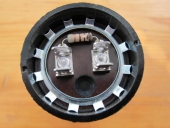



in ground heat pump
professional install $26k
DIY install (NOT for DIY)
annual energy cost $606
annual carbon footprint 8.4 tons
rocket mass heater
professional install $7k
DIY install $1.9k
annual energy cost $15
annual carbon footprint 0.4 to..
Heat pumps last about ten years. Rocket mass heaters generally last 40 to 100 years.

Gerry Parent wrote:The other day, we had no water pressure in our house. We are on a well and use a submersible water pump coupled to a pressure tank to provide all the houses water needs.

Kenneth Elwell wrote:Another component to be aware of is a “thermal cut out”, basically a fuse for heat. I replaced one in our round food dehydrator last year, it’s a $3.00 part, that bricks the whole machine.
In this machine it was crimped into eye terminals along with the leads to the heating element (which was riveted through these eyes to some heat shield boards). I managed to pry the crimping open and close it again with pliers, but that was skill and luck! Crimped connection is ideal since heat (from soldering) could ruin or shorten the life of the new TCO. Using heat sinks and a light touch would work, but that’s more soldering skill than I have right now!




joe fish wrote:Longtime lurker,
You can see it looks windy in the outside picture, Its always like this, not terribly windy, but a gentle flow, that often changes directions. Is this it???
 The woodburner here has 2x3' uninsulated flue sections and works brilliantly. It heats a tank of water in an hour or so and we can enjoy a hot "bathroom" to raise a gentle sweat, even with snow on the ground outside. It is a relatively "Heath-Robinson" affair using an old bath rescued from a skip, water from a tank catching land-drain run-off high on the hill behind, and a second-hand insulated hot water cylinder. (Safety note - the cylinder doesn't feed a tap as that could cause explosive pressure - the outlet is a simple pipe into the bath. I have a gate-valve in place of the hot tap and that allows cold water into the bottom of the tank and that, in turn, pushes the hot out the top and down into the bath! All great fun, and very simple. This is the second iteration of bath-house after the first had a fire - mice must have nested too close to the uninsulated flue going through the roof and then we had no hot water cylinder - the woodburner back boiler just heated a bath full of water. That took three hours so gave the nesting material time to ignite. Cautionary warning - use insulated flue, or make sure that nothing unwanted can come in contact with the flue.
The woodburner here has 2x3' uninsulated flue sections and works brilliantly. It heats a tank of water in an hour or so and we can enjoy a hot "bathroom" to raise a gentle sweat, even with snow on the ground outside. It is a relatively "Heath-Robinson" affair using an old bath rescued from a skip, water from a tank catching land-drain run-off high on the hill behind, and a second-hand insulated hot water cylinder. (Safety note - the cylinder doesn't feed a tap as that could cause explosive pressure - the outlet is a simple pipe into the bath. I have a gate-valve in place of the hot tap and that allows cold water into the bottom of the tank and that, in turn, pushes the hot out the top and down into the bath! All great fun, and very simple. This is the second iteration of bath-house after the first had a fire - mice must have nested too close to the uninsulated flue going through the roof and then we had no hot water cylinder - the woodburner back boiler just heated a bath full of water. That took three hours so gave the nesting material time to ignite. Cautionary warning - use insulated flue, or make sure that nothing unwanted can come in contact with the flue.


